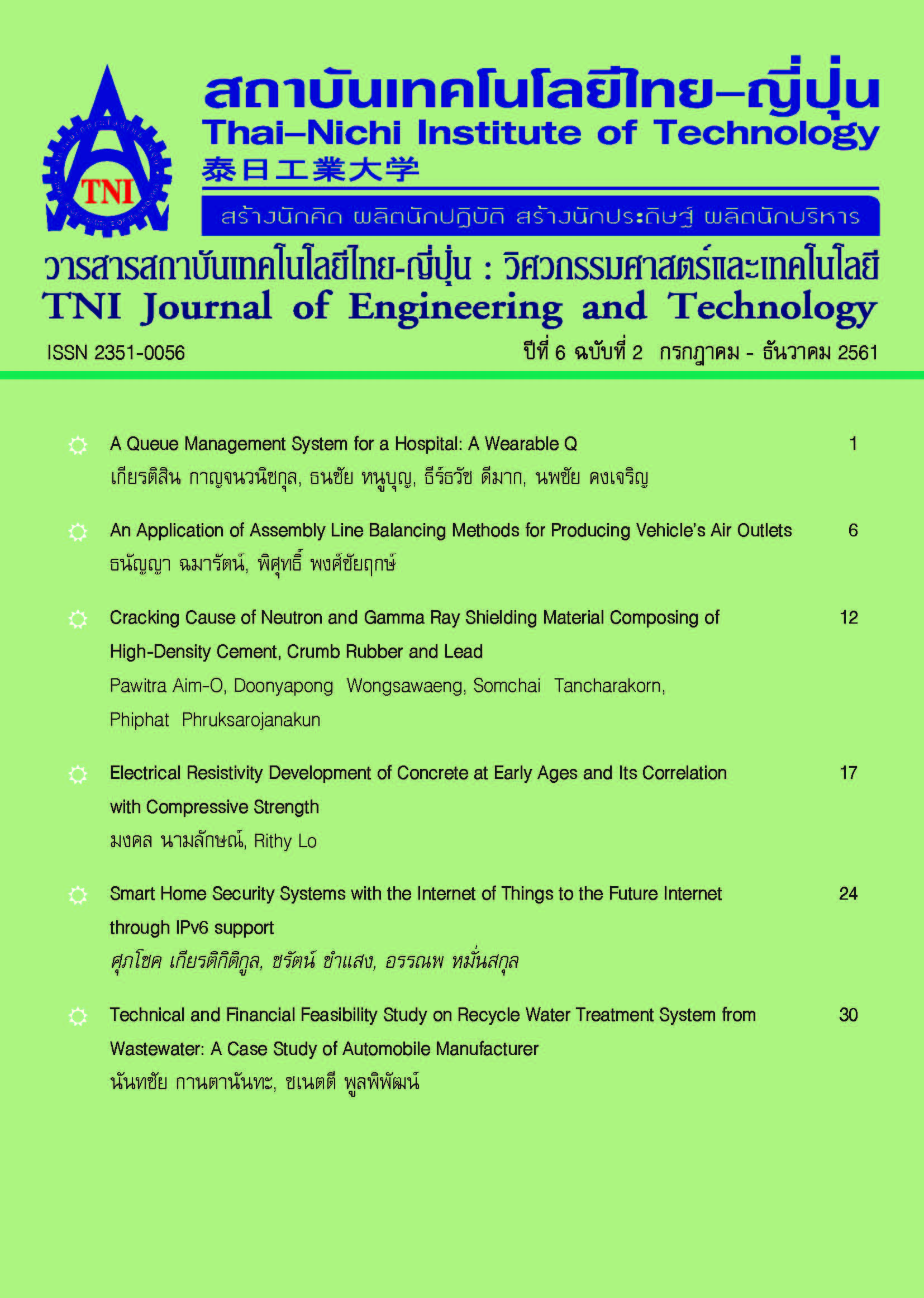Technical and Financial Feasibility Study on Recycle Water Treatment System from Wastewater: A Case Study of Automobile Manufacturer
Main Article Content
Abstract
The objective of this research is to study the possibility to take the wastewater from production and processes in the factory which are already treated by the wastewater treatment system to recycle in order to replace the tap water. The technical study of the recycle water treatment system from wastewater compares the properties of four membrane types including microfiltration, ultrafiltration, nanofiltration and reverse osmosis membranes to choose ones that are appropriate with the characteristics of the wastewater from the factory. The technical feasible alternative is then analyzed the financial aspects for decision making. According to the technical study result, it shows that the recycle water treatment system from wastewater should consist of two main membrane units, the pre-treatment unit with a microfiltration membrane and the purified unit with a reverse osmosis membrane regeneration. For the financial analysis at 10% discount rate, it shows that the net present value is 1,077,668.46 baht, the internal rate of return is 11.11% which is higher than the minimum attractive rate of return, the benefit/cost ratio is 1.03 and the discount payback period is 13 years and 2 months, indicating that the project is feasible to invest. The sensitivity analysis varies four factors within the range of ±25% including the capital investment cost, the benefit, the operating expenses and the discount rate. The changes in the factors that result in the infeasibility of the project are 10% increase in the capital investment cost, 10% increase in the operating expenses, 5% decrease in the benefit and 15% increase in the discount rate.
Article Details
Article Accepting Policy
The editorial board of Thai-Nichi Institute of Technology is pleased to receive articles from lecturers and experts in the fields of business administration, languages, engineering and technology written in Thai or English. The academic work submitted for publication must not be published in any other publication before and must not be under consideration of other journal submissions. Therefore, those interested in participating in the dissemination of work and knowledge can submit their article to the editorial board for further submission to the screening committee to consider publishing in the journal. The articles that can be published include solely research articles. Interested persons can prepare their articles by reviewing recommendations for article authors.
Copyright infringement is solely the responsibility of the author(s) of the article. Articles that have been published must be screened and reviewed for quality from qualified experts approved by the editorial board.
The text that appears within each article published in this research journal is a personal opinion of each author, nothing related to Thai-Nichi Institute of Technology, and other faculty members in the institution in any way. Responsibilities and accuracy for the content of each article are owned by each author. If there is any mistake, each author will be responsible for his/her own article(s).
The editorial board reserves the right not to bring any content, views or comments of articles in the Journal of Thai-Nichi Institute of Technology to publish before receiving permission from the authorized author(s) in writing. The published work is the copyright of the Journal of Thai-Nichi Institute of Technology.
References
N. Atanasova, M. Dalmau, J. Comas, M. Poch, I. Rodriguez-Roda, and G. Buttiglieri, “Optimized MBR for greywater reuse systems in hotel facilities,” Journal of Environmental Management, vol. 193, pp. 503–511, May 2017.
ธีรพงศ์ สว่างรัตน์, “การศึกษาความเป็นไปได้ในการนำกลับน้ำเสียมาใช้ใหม่ในระบบชักโครกด้วยระบบกรองคาร์บอนและฆ่าเชื้อโรคด้วยคลอรีน,” วิทยานิพนธ์ วิศวกรรมศาสตรบัณฑิต (สิ่งแวดล้อม), มหาวิทยาลัยเกษตร ศาสตร์, กรุงเทพฯ, 2551.
“การวิเคราะห์โครงการ,” มหาวิทยาลัยสุโขทัยธรรมาธิราช. [ออนไลน์]. แหล่งที่มา: https://www.stou.ac.th/stouonline/lom/data/sec/Lom14/poll. html. [เข้าถึงเมื่อ: 17-ก.พ.-2560].
A. Marchioni and C. A. Magni, “Investment decisions and sensitivity analysis: NPV-consistency of rates of return,” European Journal of Operational Research, vol. 268, no. 1, pp. 361–372, Jul. 2018.
ทนงศักดิ์ วัฒนา, “เรียนรู้การรีไซเคิลน้ำเพื่อการใช้น้ำที่ยั่งยืน,” วารสารส่งเสริมเทคโนโลยี, ปีที่ 39, ฉบับที่ 225, หน้า 71-74, ตุลาคม-พฤศจิกายน 2555.
I. Petrinic, J. Korenak, D. Povodnik, and C. Hélix-Nielsen, “A feasibility study of ultrafiltration/reverse osmosis (UF/RO)-based wastewater treatment and reuse in the metal finishing industry,” Journal of Cleaner Production, vol. 101, pp. 292–300, Aug. 2015.
J. Garcia-Ivars, L. Martella, M. Massella, C. Carbonell-Alcaina, M.-I. Alcaina-Miranda, and M.-I. Iborra-Clar, “Nanofiltration as tertiary treatment method for removing trace pharmaceutically active compounds in wastewater from wastewater treatment plants,” Water Res., vol. 125, pp. 360–373, Nov. 2017.
A. Suárez, P. Fernández, J. Ramón Iglesias, E. Iglesias, and F. A. Riera, “Cost assessment of membrane processes: A practical example in the dairy wastewater reclamation by reverse osmosis,” Journal of Membrane Science, vol. 493, pp. 389–402, Nov. 2015.
R. Ordóñez, D. Hermosilla, I. S. Pío, and Á. Blanco, “Evaluation of MF and UF as pretreatments prior to RO applied to reclaim municipal wastewater for freshwater substitution in a paper mill: A practical experience,” Chemical Engineering Journal, vol. 166, no. 1, pp. 88–98, Jan. 2011.

